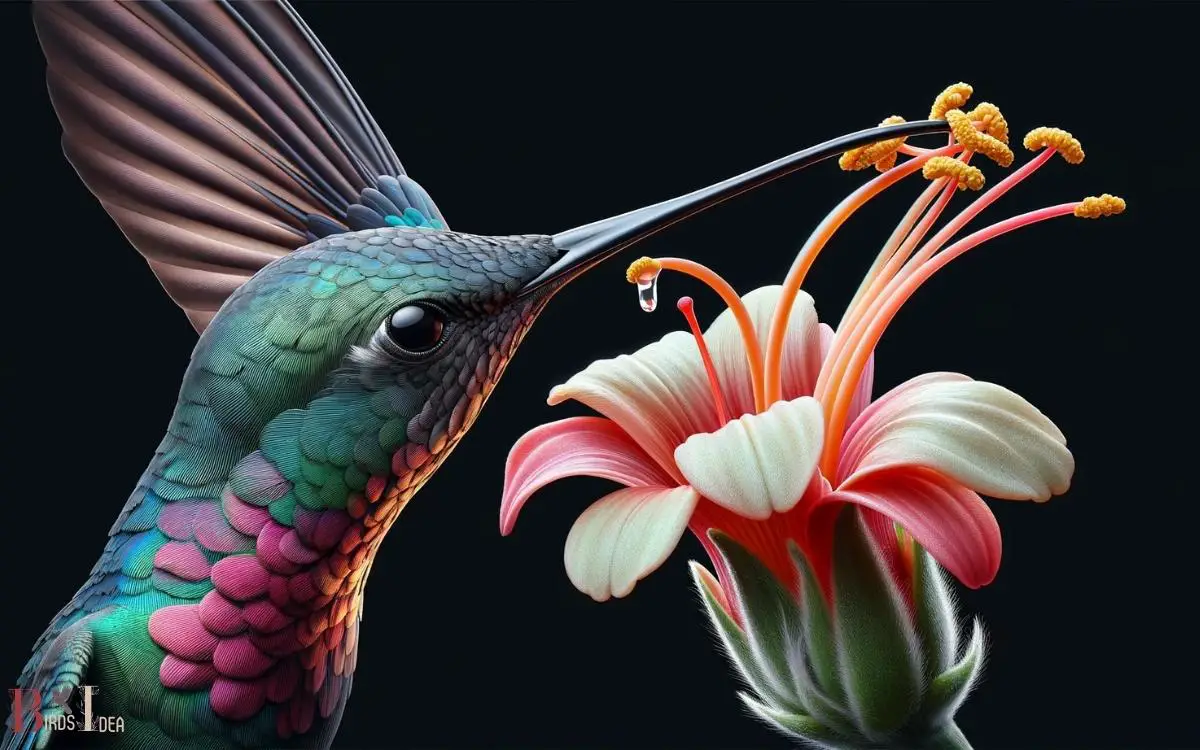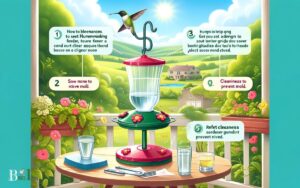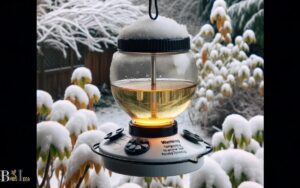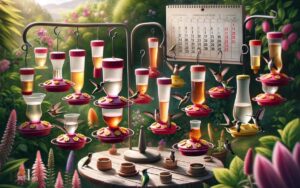How Does a Hummingbird Drink? Specialized Long!
Hummingbirds drink using their specialized long, slender beaks and an extendable, tube-like tongue designed for efficient nectar extraction from flowers.
Their tongues have tiny hair-like extensions called lamellae that help lap up nectar like a pump.
When a hummingbird feeds:
Effortlessly, the hummingbird’s tongue acts like a nectar pump, showcasing a perfect blend of biology and physics in action.

Key Takeaway
The Anatomy of a Hummingbird’s Beak
The anatomy of a hummingbird’s beak enables it to efficiently extract nectar from flowers during feeding.
Hummingbird beaks are uniquely adapted for their nectar-based diet. They are long, slender, and taper to a fine point, allowing them to reach deep into flowers to access nectar.
The beak is also flexible, which aids in maneuvering around the intricate shapes of flowers. Moreover, the beak is equipped with a long, extendable, and highly sensitive tongue that can lap up nectar at a rate of 13 licks per second.
This efficient design allows hummingbirds to access the energy-rich nectar they need to sustain their high metabolism.
The specialized beak structure exemplifies the remarkable adaptation of hummingbirds to serve their unique dietary needs.
The Unique Feeding Behavior of Hummingbirds
Hummingbirds exhibit a unique feeding behavior characterized by their ability to hover in mid-air while extracting nectar from flowers.
This remarkable behavior sets them apart from other bird species and captivates the attention of bird enthusiasts and nature lovers.
Here are some intriguing aspects of their feeding behavior:
- Hovering: Hummingbirds can hover in front of a flower by rapidly flapping their wings, allowing them to access nectar from delicate blossoms.
- Agility: Their exceptional agility enables them to dart from one flower to another with precision and speed.
- Feeding frequency: Despite their small size, hummingbirds need to feed frequently, visiting hundreds of flowers each day to meet their high metabolic demands.
- Territorial behavior: They fiercely defend feeding territories, ensuring a consistent nectar supply for themselves.
- Specialized bill shape: Their long, slender bills are adapted for reaching deep into flowers to access nectar.
The unique feeding behavior of hummingbirds is a testament to their remarkable adaptations for nectar consumption and energy requirements, setting the stage for a discussion on how hummingbirds use their tongues to drink.
How Hummingbirds Use Their Tongues to Drink?
Using a specialized tubular tongue, hummingbirds efficiently extract nectar from flowers with remarkable precision and speed.
The hummingbird’s tongue has a unique structure that enables it to lap up nectar at a rate of up to 13 licks per second.
The tongue is split at the tip and fringed with tiny, hair-like projections called lamellae, which open and trap nectar when inserted into flowers.
As the tongue retracts, the nectar is drawn into the bill. This process is aided by the rapid capillary action of the tongue, allowing the bird to maximize the amount of nectar obtained with each feeding.
Hummingbirds have evolved this highly specialized tongue to efficiently extract the energy-rich nectar they require to sustain their incredibly high metabolism.
The Importance of Water for Hummingbirds
Hummingbirds require access to water for hydration, a crucial element in supporting their metabolic needs and overall health. Water is essential for their survival and plays a vital role in their daily lives.
Here are some key reasons why water is important for hummingbirds:
- Hydration: Just like any other living creature, hummingbirds need water to stay hydrated.
- Digestion: Water aids in the digestion of food, helping hummingbirds process the nectar they consume.
- Thermoregulation: Water assists in regulating body temperature, especially in hot climates.
- Feather maintenance: Hummingbirds use water to clean and maintain their feathers, ensuring efficient flight.
- Overall health: Adequate water intake is crucial for the overall health and well-being of hummingbirds.
Understanding the importance of water for hummingbirds sets the stage to explore the fascinating adaptations for drinking in hummingbirds.
The Fascinating Adaptations for Drinking in Hummingbirds
Hummingbirds possess remarkable adaptations that enable them to feed on nectar and drink water in unique ways.
Their specialized beak structures allow for precision and efficiency when sipping nectar from flowers, while their high-speed hovering feeding technique sets them apart from other bird species.
These adaptations not only showcase the agility and grace of hummingbirds but also highlight their ability to thrive in diverse environments.
Unique Beak Structure
The unique beak structure of hummingbirds is a remarkable adaptation that allows for efficient drinking.
Hummingbirds possess specialized beaks that enable them to access nectar from flowers and feeders with precision and speed.
This adaptation includes:
- Long, slender beaks that can reach deep into flowers to access nectar.
- Specially shaped and grooved tongues that allow them to lap up nectar.
- Flexible beaks that can open wide to catch insects in mid-air.
- Ability to rapidly close their beaks to create a suction force for extracting nectar.
- Enhanced sensory perception in their beaks to detect the sugar content of the nectar.
These unique features enable hummingbirds to thrive by efficiently obtaining the nutrients they need while serving as important pollinators for numerous plant species.
High-Speed Hovering Feeding
With remarkable precision and agility, hummingbirds execute high-speed hovering feeding, showcasing fascinating adaptations for drinking.
To achieve this impressive feat, hummingbirds have evolved unique anatomical and physiological characteristics.
Their specialized bill and tongue structures enable them to swiftly extract nectar from flowers while hovering in mid-air.
The hummingbird’s long, slender bill allows it to reach deep into the flower to access nectar, while its bifurcated tongue, which is fringed with tiny, hair-like projections, can rapidly lap up the sugary liquid.
Their exceptionally rapid metabolism and high energy demands drive them to consume large quantities of nectar, further highlighting the necessity for their high-speed feeding abilities.
These remarkable adaptations not only facilitate the hummingbird’s survival but also serve as a testament to the intricate ways in which nature equips creatures for their roles in the ecosystem.
What Makes a Hummingbird’s Drinking Method Special and Efficient?
Hummingbirds drink through a unique method that sets them apart from other birds. Using their long, thin beaks, they insert them into flower nectar. With a rapid flick of the tongue, they capture the nectar, often as much as 13 times per second. This incredible drinking technique, known as “how hummingbirds drink,” allows them to efficiently extract the nectar they need to fuel their high-energy activities.
How Much Do Hummingbirds Drink?
Hummingbirds are known for their high metabolism and energy requirements. On average, a hummingbird can consume about half of its body weight in nectar each day. This translates to a daily intake of several times their own weight in nectar.
Hummingbirds have a rapid heartbeat and a high rate of respiration to support their active lifestyle, and they need to replenish their energy reserves frequently.
The exact amount of nectar consumption can vary depending on factors such as the species of hummingbird, the availability of nectar sources, and environmental conditions.
During the breeding season, female hummingbirds may consume even larger amounts of nectar to support the energy demands of egg-laying and feeding their chicks.
In addition to nectar, hummingbirds also feed on small insects and spiders for protein. Water is also essential for their survival, and they obtain it from the nectar they consume and by drinking water directly.
Overall, the daily fluid intake of a hummingbird is a crucial aspect of its diet and is necessary to sustain its high-energy lifestyle.
Conclusion
The unique anatomy and feeding behavior of hummingbirds allow them to drink nectar and water with remarkable speed and efficiency.
Their specialized beaks and tongues, combined with rapid wing beats, enable them to access the essential nutrients they need to survive.
The phrase “like a well-oiled machine” perfectly captures the impressive adaptations that hummingbirds have developed for drinking, showcasing their incredible evolutionary success in the natural world.






